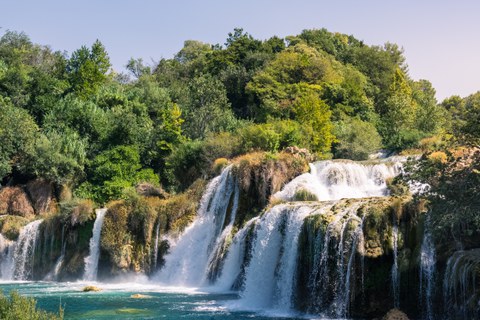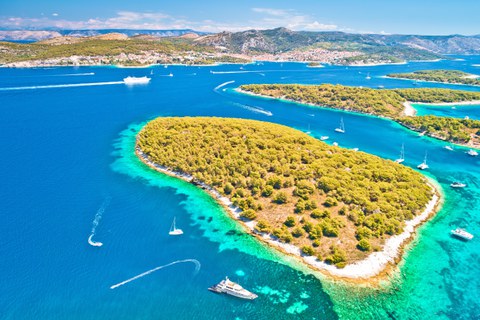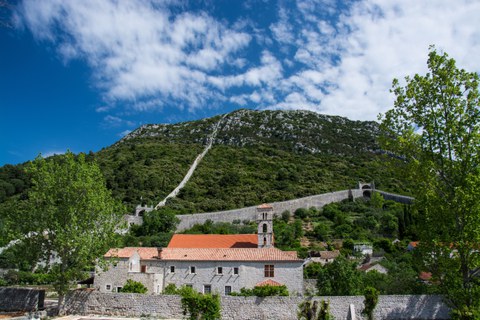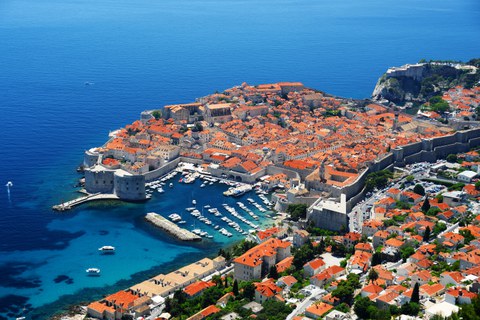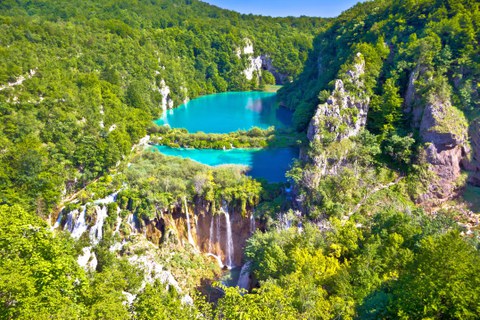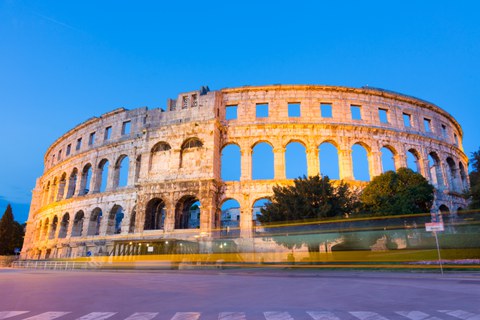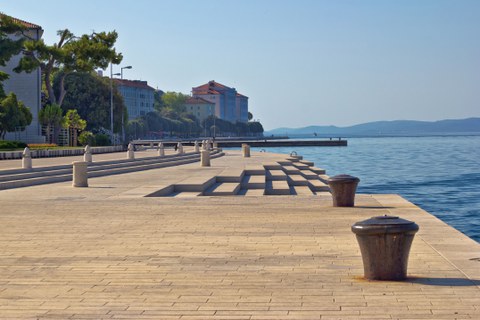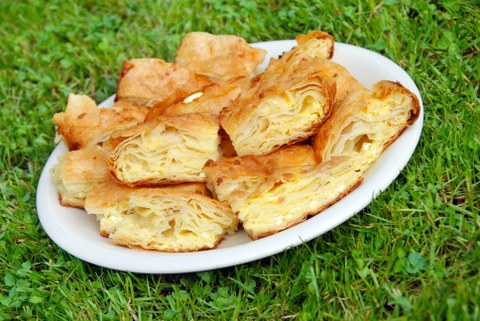Partner Country of the Month January 2023: Croatia
Croatia is quite rightly a popular holiday destination. Its nature impresses with waterfalls, the island-rich Adriatic coast and rugged karst landscapes. Add to that medieval old towns ready to be a film set and an easy-going people. Sounds good for a semester abroad? The country of Dalmatian dogs and new member of the Schengen Area is an exciting mixture of Central and South-Eastern Europe, with much to discover.
With the "Partner Country of the Month" campaign, we want to shine a spotlight on the wide diversity of countries, regions and partner universities of TU Dresden that our students can explore during a semester abroad.
Table of contents
General facts and figures about Croatia
Capital: Zagreb
Population: 3.89 million (2021)
Official language: Croatian, regionally also various minority languages
National holiday: May 30th (Statehood Day, birth of an independent Croatian state)
Currency: Euro
You can find further facts, figures and information on wikipedia, on croatiaweek.com, or e.g. on wikivoyage.
Language matters
- Hi / Bye – Bok
- Good day – Dobar Dan
- Goodbye – Doviđenja [Dovijenya]
- I only speak a little bit of Croatian - Govorim samo malo hrvatski
- Please – Molim
- Thank you – Hvala
- Excuse me – Oprostite
- Yes / no – Da / ne
Croatian, or hrvatski, is part of the Slavic language family. It’s closely related to the languages of neighbouring Serbia, Bosnia and Herzegovina and Montenegro. While the grammar of Croatian is complex, its phonetic spelling using the Latin alphabet is an advantage for learners. Even words borrowed from other languages are spelled as they are spoken, like kompjuter and dizajn (computer and design). However, instead of simply adopting foreign words for new concepts, the preferred option is to invent new Croatian words.
Some Croatian words can make do without any vowels, such as prst (finger), crn (black) or brz (quick). But don't worry, it's not as impossible to pronounce as it may seem at first.
Our partner universities offer Croatian and English as languages of instruction. The selection of courses taught in English is large, and you can study entirely in English during a semester abroad. However, please check the exact requirements before applying.
Younger Croatians, especially in the cities, usually speak English very well. So you also don't need to worry about the language barrier outside of university. However, learning some basic Croatian will earn you a lot of extra sympathy points and help you get to know the culture. Zagreb University offers a free online Croatian course at levels A1 and A2. You can find other options online, such as easy-croatian.com.
Did you know that ....?
- the origin of neckties lies in Croatia? In the 17th century, Croat cavalry units served in many European armies. Before going off to war, their sweethearts in Croatia tied scarves around their necks as a keepsake. They were tied with a knot at the collar and the ends hanging down over the chest. Legend has it that the Croats' fancy scarves caught the attention of French king Louis XIV at a parade of troops in Versailles. The French nobility then adopted the style à la croate, which slowly morphed into à la cravate and then to the cravat, the forerunner of the modern necktie. In Croatia, people are proud of the invention and even dedicate a holiday to it, Cravat Day on 18 October. In 2003, the world's largest necktie was tied around the amphitheatre in Pula to mark the occasion.
- Croatia has a unique water sport using peeled tennis balls? Picigin originated on the beach of Split and is played in shallow water. Five players throw the ball to each other and try to keep it in the air. Using the small tennis ball, with its felt peeled away, is what makes the game special. Players bounce it off the flat of their palms. That's not easy, and to keep the ball from falling into the water, players pull off wild jumps and falls. The particularly tough players even play it on the beach of Split on New Year's Day.
- blond people are blue-haired in Croatia? The word plav means blue but is also used for blond hair. The likely explanation is that plav used to describe pale colours and only later took on the meaning of blue.
-
famous inventor Nikola Tesla can easily become a subject of dispute in Croatia? His parents came from Serbia, but Tesla himself was born and raised in Croatia. Both countries like to claim him as their own. Since the relationship between Croatia and Serbia is marked by the war surrounding the disintegration of federate Yugoslavia in the 1990s, heated discussions can quickly ensue.
-
the Witcher games and the new Croatian euro coins have something in common? Both make use of the Glagolitic script, the oldest known alphabet for Slavic languages. In most regions it got replaced by the Cyrillic or Latin alphabet during the Middle Ages. Croatia was the only place where Glagolitic continued to be in general use until the 18th century. To this day, the angular script is considered a symbol of Croatian culture and it’s often used as decoration in Croatia.
-
the longest fortress wall in the world after the Great Wall of China is located in Croatia? The 5.5 km long Walls of Ston were built from the 14th century onwards to protect the small town of Ston and its nearby saltworks. Ston's salt used to be a great source of wealth for the Republic of Ragusa, a maritime trading power centered in Dubrovnik, now part of Croatia.
Cooperation with TU Dresden
You can find all cooperations of TU Dresden in our database. Have a look at the experiences of our previous exchange students at Questionnaires. Professors at your faculty may have direct contacts to your partner university of choice and can advise you.
Our cooperations with Croatian universities are part of Erasmus+. You can find the contact persons and application deadlines for your faculty here.
Our Croatian partner universities via Erasmus+
- University of Zagreb:
- Biology
- Mathematics
- History of Art
- German as a Foreign Language
- Transport Engineering
- University of Dubrovnik: Business Administration and Economics
- University of Rijeka: Civil Engineering
- University of Split: Biology
- University of Zadar: German Language and Literature
Don't miss...
The Old Town of Dubrovnik. At least since having been the film set for King's Landing in Game of Thrones, our partner city's beautiful historical center is world-famous. When exploring its streets, you will find picturesque churches, palaces and fountains. The free drinking water dispensed by the fountains comes from an aqueduct that has been supplying the city for more than 500 years. Speaking of water, you can also go swimming in Dubrovnik, for example on the rocky coast below Mala Buža bar. A walk over the city walls or a visit to Fort Lovrijenac are also worthwhile for their great views of the old town.
Plitvice Lakes National Park. As Croatia's oldest national park and one of the first landscapes to be declared a UNESCO World Heritage Site, Plitvice Lakes can only be something very special. The 16 small and large lakes are separated by limestone barriers formed over thousands of years. 130 metres in altitude, a transition from gentle hills to rugged cliffs and countless waterfalls lie between the uppermost and the lowermost lake. Depending on the minerals contained in the water, its colour changes from turquoise blue to emerald green. There are daily buses to the national park from Zagreb, Zadar and Split.
Pula Arena. You would like to visit the Colosseum in Rome? No need to leave Croatia for that. The city Pula, about three hours by bus from our partner city Rijeka, boasts one of the largest and most well-preserved ancient Roman amphitheatres. In former times, about 23,000 people could watch gladiator fights and probably even sea battles here. Events still take place in the theatre today, such as Pula Film Festival in summer. At the festival, you can watch Croatian and European films. The best of them receive awards.
The Sea Organ of Zadar is played by the waves of the sea and the wind. The experimental musical instrument made of tubes and a resonating cavity is hidden under our partner city's waterfront promenade. You can let yourself be lulled by the atmospheric music sitting on the steps by the water or in the nearby park. In the evening, the Sea Organ is a popular place to enjoy Zadar's beautiful sunsets. In midsummer, a special event takes place on the waterfront. On the Night of the Full Moon, the electric lighting is replaced by torches and candles. In this special atmosphere, you can taste local delicacies from the numerous stalls and enjoy small performances.
Let's get cooking...
Croatian cuisine is varied and thrives on fresh ingredients. On the coast, there’s a lot of fish and seafood. Italian influences show in dishes such as pasta and risotto. In Northern Croatia, dishes like sweet strudel or germknedle reveal Austrian and Hungarian influences. Dalmatia's best-known dish Pašticada is an exciting combination of this: it’s goulash on gnocchi or noodles. Vegetarians and vegans will have a hard time with typical Croatian cuisine, as meat and dairy products are important ingredients. But they can enjoy a huge variety of fresh vegetables. Not to be missed is Ajvar, a sauce speciality of Balkan cuisine made from roasted peppers, which can be used as a dip, spice or spread.
Hearty Gibanica with Ajvar
Gibanica is a pastry which combines two typical Croatian ingredients. The first is, of course, Ajvar. The second ingredient is sheep's cheese. In Croatia, you can get the best sheep's cheese at the market stalls of the numerous family cheese dairies. In Germany, feta cheese from the supermarket will do. In addition to the savoury version that we present here, there is also the sweet Međimurska Gibanica, in which poppy seeds, cream cheese, walnuts and grated apples are layered between thin pieces of dough.
Ingredients for 4 servings:
- 500 ml milk
- 100 ml sparkling mineral water
- 200 g sour cream
- 4 eggs
- 200 g feta cheese
- 400 g dough: filo, yufka or puff pastry
- salt
- pepper
- a little oil
- Ajvar (from a well-stocked supermarket or homemade)
- You will also need a baking tin
Preparation:
1. Mix the sour cream with the eggs, milk and mineral water. Then finely crumble in the feta. Season with salt and pepper.
2. Brush the baking tin with oil. Place a large pastry sheet on the bottom of the tin, with its edges hanging slightly over the rim of the tin.
3. Tear the remaining pastry sheets into rough strips or shreds and pull them through the egg and sour cream mixture. Make sure that pieces of feta also stick to the dough.
4. Crumple up the wet dough shreds and place them in the dish. Do the same with the remaining pieces of dough until all the pieces have been layered into the tin.
5. Once all the pastry sheets are in the tin, pour the remaining egg and sour cream mixture over the pastry sheets and place in the oven at 180°C.
6. After about an hour, check with a wooden stick if the cake is done. If there is still a lot of liquid on the stick, bake for another 5-10 minutes.
7. Serve with Ajvar. Dobar tek!
(Many thanks to papiliomaackii.blogspot.com!)
Contact
Have you had a great time in Croatia? Do you have tips for places and experiences that are not to be missed? We would be happy to share your experiences here, on social media or, if you want, in information events for other TUD students. Get in touch with us:
 © Sven Ellger/TUD
© Sven Ellger/TUD
Advice on studying abroad
NameMs Federica Serra
Infocenter/ Study abroad; TUDworldwide: America
Send encrypted email via the SecureMail portal (for TUD external users only).
Visiting address:
Fritz Foerster Bau, Office 161 Mommsenstraße 6
01069 Dresden
Postal address:
TUD Dresden University of Technology International Office
01062 Dresden
Office hours:
- Tuesday:
- 09:30 - 11:30
- 12:30 - 14:30
- Thursday:
- 09:30 - 11:30
Please register at the SCS (FOE, floor 0). No office hours from 9 to 17 October 2025. On 9 October, you can find us at our information stand at the matriculation ceremony.
Partner Countries Archive
Have you missed a partner country? No worries! Here you can read up on all articles.
|
Europe (Erasmus+) |
|
|
Africa |
|
|
America |
|
|
Asia |
|
|
Australia and Oceania |
|

